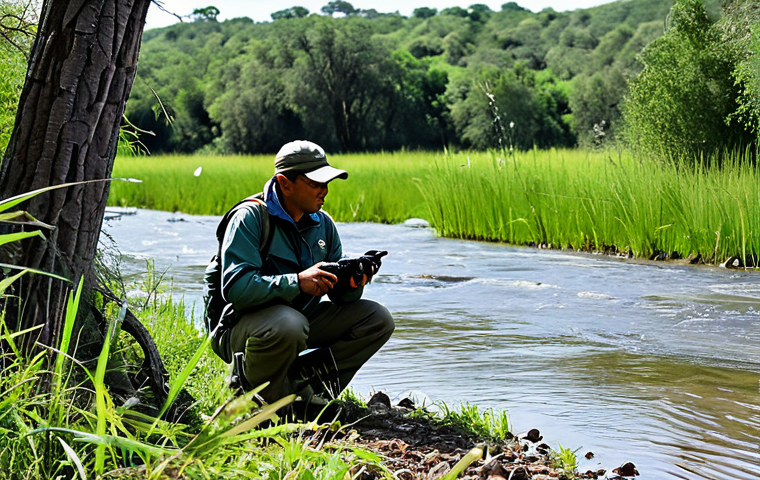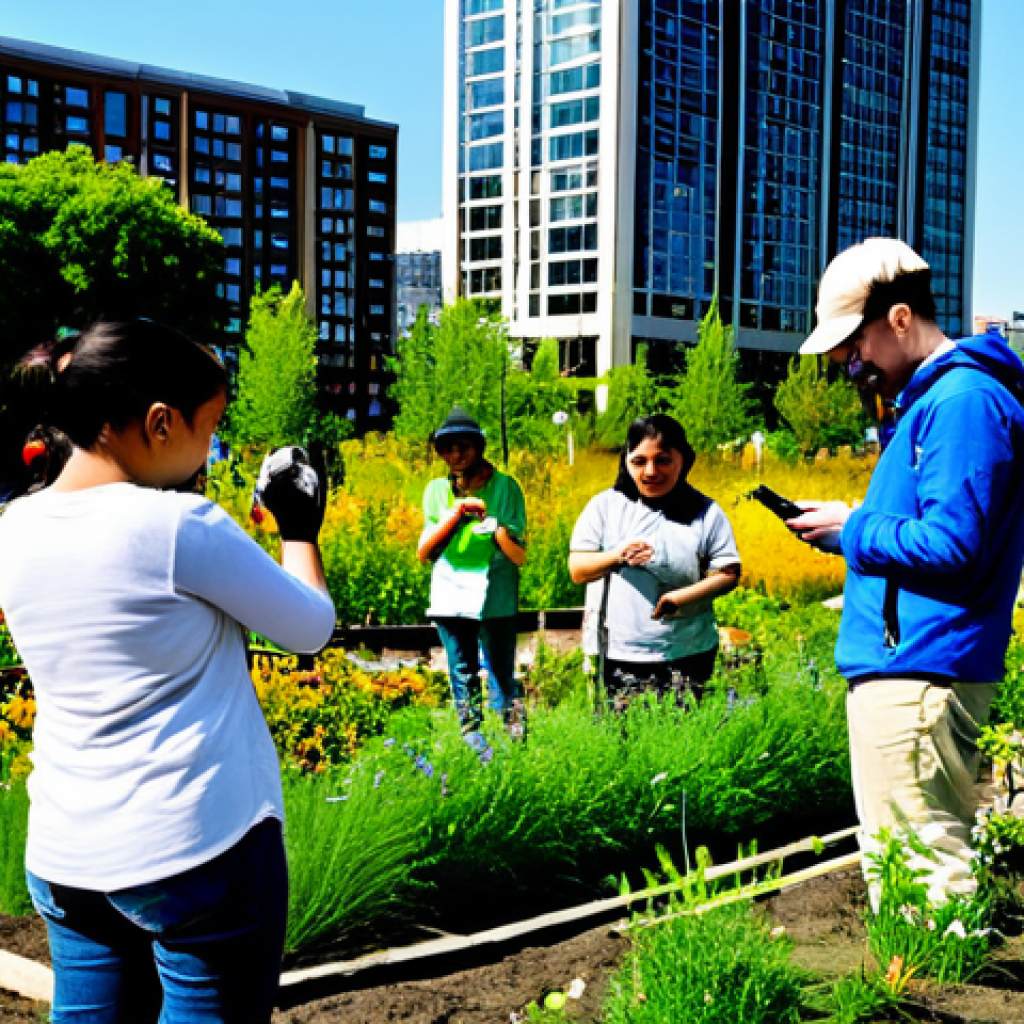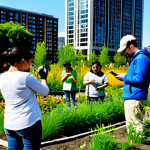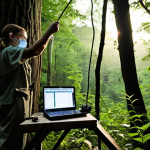Have you ever stopped to truly appreciate the intricate web of life around us? From the towering redwoods in California to the buzzing pollinators in your backyard, biodiversity isn’t just a scientific concept; it’s the very foundation of our existence.
Lately, I’ve felt a growing urgency to discuss how we, as individuals and communities, can actually *do* something meaningful. It’s not enough to just talk about the problem anymore; it’s time for actionable steps.
I’ve personally witnessed how powerful even small local initiatives can be, like community clean-up drives or native plant restoration projects in urban parks – they really do make a tangible difference.
It’s a bit overwhelming, I know, when you think about global species loss, but what often goes unsaid is the incredible array of practical techniques emerging.
We’re seeing everything from cutting-edge AI being deployed for real-time wildlife monitoring and drone technology mapping critical habitats, to everyday citizens contributing vital data through apps like iNaturalist.
The future of conservation, in my view, increasingly hinges on these accessible, hands-on approaches combined with smart tech. This isn’t just for scientists in faraway labs; it’s for all of us.
Local governments and grassroots organizations are leaning into nature-based solutions more than ever, realizing that protecting ecosystems isn’t just about saving species, but also about building resilience against climate change impacts right in our neighborhoods.
Let’s explore precisely what these techniques entail.
Empowering the Everyday Conservationist: The Citizen Science Revolution

It’s easy to feel small and insignificant when faced with the enormous challenge of biodiversity loss, but one of the most exciting shifts I’ve personally witnessed is the rise of citizen science. This isn’t just about scientists in labs anymore; it’s about regular folks like you and me contributing vital data that fuels real conservation efforts. I remember my first time using iNaturalist – stumbling upon a rare native orchid during a hike and being able to instantly document it, contributing to a global database. It felt incredibly empowering. This direct participation transforms us from passive observers into active participants, and the sheer volume of data collected by millions of people across diverse landscapes provides insights that traditional research methods simply couldn’t achieve alone. It’s truly inspiring to see how these seemingly small individual acts collectively build a monumental force for good, providing invaluable, granular data on species distribution, population changes, and even the spread of invasive species right in our local communities.
1. The Magic of Mobile Apps: iNaturalist, eBird, and Beyond
The accessibility of smartphones has been a game-changer. Apps like iNaturalist allow anyone to snap a photo of an unknown plant or animal, upload it, and have it identified by a community of experts. What’s even cooler is that this data feeds directly into scientific databases used by researchers and policymakers. Similarly, eBird has revolutionized bird watching, enabling birders worldwide to log their sightings, creating an immense real-time dataset of avian populations and migratory patterns. I’ve found myself spending hours immersed in these apps, not just for the thrill of identification, but because I know my observations are genuinely helping track biodiversity health. It’s like being part of a massive, distributed research team, and the immediate feedback loop of seeing your contributions validated is incredibly motivating.
2. Local Bioblitzes and Community Surveys
Beyond the apps, many local conservation groups organize “bioblitzes,” which are intensive surveys of all living species within a specific area over a short period, often 24 hours. I once participated in a park bioblitz right here in my city, and it was an eye-opener. Working alongside professional biologists and other volunteers, we meticulously identified everything from obscure insects under logs to different types of fungi on trees. These events not only generate crucial baseline data for urban planning and park management but also foster a deep sense of community and connection to the local environment. It’s a fantastic way to learn from experts and contribute meaningfully, creating a tangible impact on local conservation strategies.
Greening Our Concrete Jungles: Urban Biodiversity Initiatives
When we talk about biodiversity, our minds often jump to remote rainforests or vast oceans. But what about our backyards, our parks, and the spaces right outside our windows? Urban areas, often seen as ecological deserts, are actually ripe for biodiversity enhancement. I’ve personally been involved in transforming a neglected strip of land near my apartment into a vibrant pollinator garden, and the change has been astonishing – a true testament to the resilience of nature when given a chance. These urban initiatives are vital not just for the species they support, but for the profound impact they have on human well-being, bringing nature closer to where most people live and work. It’s about recognizing that every green space, no matter how small, has the potential to be a crucial stepping stone or refuge for wildlife within the urban mosaic.
1. Community Gardens and Native Plant Restoration
One of the most accessible and rewarding ways to boost urban biodiversity is through community gardens and native plant restoration projects. Instead of manicured lawns that offer little ecological value, converting even small plots into native plant habitats provides essential food and shelter for local insects, birds, and small mammals. I’ve seen community gardens become bustling hubs of activity, not just for people growing food, but for bees, butterflies, and various songbirds. Planting native species, which are adapted to the local climate and soil, also reduces the need for excessive water and pesticides, making them a sustainable choice that supports the entire local food web. It’s a simple yet profoundly effective strategy.
2. Green Roofs and Vertical Gardens
Looking up, literally, we find incredible opportunities for biodiversity in urban settings through green roofs and vertical gardens. These innovative solutions transform otherwise barren rooftops and walls into thriving mini-ecosystems. I’ve visited buildings with extensive green roofs that host surprising arrays of plant and insect life, even attracting migratory birds. Not only do these installations provide habitat, but they also offer numerous benefits for humans, like reducing urban heat island effects, improving air quality, and managing stormwater runoff. It’s a win-win, turning dead space into living, breathing ecological infrastructure that plays a crucial role in city-wide biodiversity networks.
Harnessing Technology for Wildlife: Smart Tools in Action
In recent years, the intersection of technology and conservation has truly exploded, offering powerful new ways to monitor, protect, and understand the natural world. I’ve been fascinated by how innovations previously confined to sci-fi movies are now being deployed in the field, making conservation efforts more efficient, accurate, and scalable than ever before. From tracking elusive animals to mapping vast, inaccessible terrains, these smart tools are providing unprecedented insights and allowing conservationists to make more informed decisions. It feels like we’re finally catching up, leveraging human ingenuity to give nature a much-needed boost in its fight for survival. This isn’t just about fancy gadgets; it’s about strategic application of cutting-edge resources to tackle complex ecological challenges with precision and speed.
1. Drones and Remote Sensing for Habitat Mapping
Drones equipped with advanced cameras and sensors are revolutionizing how we map and monitor habitats. Previously, surveying vast forest canopies or remote wetlands was a logistical nightmare, often dangerous and costly. Now, drones can swiftly capture high-resolution imagery, identify deforestation, track land-use changes, and even detect specific species. I’ve seen incredible footage from conservation projects using drones to monitor elusive pangolins or map illegal logging operations in real-time. This aerial perspective provides an unparalleled advantage, allowing conservationists to identify critical areas in need of protection or intervention with incredible speed and accuracy.
2. AI, Camera Traps, and Acoustic Monitoring
Artificial intelligence is emerging as a silent hero in conservation. AI algorithms can sift through vast amounts of data from camera traps, which are motion-activated cameras placed in the wild, identifying specific animals and even individuals. This dramatically speeds up species population assessments and behavioral studies. Similarly, acoustic monitoring, using automated sound recorders, coupled with AI, can detect the presence of specific species by their calls, even nocturnal or shy ones, without disturbing them. Imagine being able to monitor the health of a rainforest just by listening! I find this particularly exciting because it allows for non-invasive, continuous monitoring, giving us a clearer picture of biodiversity health without disrupting sensitive ecosystems.
Here’s a quick overview of some of these impactful technologies:
| Technology | Primary Conservation Use | Example Application |
|---|---|---|
| Citizen Science Apps | Crowdsourced data collection on species distribution and abundance. | iNaturalist: Identifying unknown species and contributing observations. |
| Drones/UAVs | High-resolution mapping, surveillance, and habitat monitoring. | Mapping deforestation in the Amazon or tracking animal herds. |
| AI & Machine Learning | Automated data analysis, species identification, anomaly detection. | Analyzing camera trap photos for tiger populations; detecting poaching sounds. |
| Acoustic Monitoring | Non-invasive detection and monitoring of vocalizing species. | Listening for specific bird calls to track population health in remote areas. |
| GPS Tracking Devices | Real-time animal movement tracking and behavioral studies. | Following migratory patterns of whales or elephants to protect corridors. |
Beyond the Backdoor: Sustainable Living and Consumer Choices
It’s easy to feel like our individual actions don’t matter in the grand scheme of things, but I’ve come to realize that our daily choices, particularly those related to what we consume, have a ripple effect that extends globally. From the food we eat to the products we buy, every decision can either contribute to biodiversity loss or support its preservation. This isn’t about perfection; it’s about making more conscious, informed choices wherever possible. I’ve personally found that once you start looking at the origins of products, it becomes a fascinating journey into supply chains and environmental impacts. It’s a powerful way for individuals to exert influence, shaping market demand towards more sustainable and biodiversity-friendly practices. Every time we choose wisely, we’re sending a clear message to producers about what we value.
1. Mindful Consumption and Ethical Sourcing
One of the most direct ways to protect biodiversity through consumer choices is by being mindful of what we buy. This means looking for products that are ethically sourced and sustainably produced. Think about certified sustainable seafood, products with fair-trade labels, or timber from responsibly managed forests. Avoiding products that contribute to deforestation, like those containing unsustainable palm oil, is another crucial step. I’ve started making it a point to research brands and their environmental commitments, and while it takes a little extra effort, the peace of mind knowing I’m not inadvertently harming ecosystems is absolutely worth it. It’s about leveraging our purchasing power as a force for good.
2. Reducing Your Footprint: Energy, Waste, and Water
Our daily habits around energy, waste, and water consumption also directly impact biodiversity. The energy we use, for instance, often comes from sources that contribute to habitat destruction or climate change. Switching to renewable energy providers, reducing household energy consumption, and embracing public transport or active travel options can significantly lessen our impact. Similarly, reducing waste, especially plastics, prevents pollution that harms countless marine and terrestrial species. I’ve become a huge advocate for composting and minimizing single-use items, and honestly, it’s not as hard as it sounds once you get into the swing of it. Every drop of water we save, every item we recycle, and every bit of energy we conserve collectively reduces the pressure on natural resources and the ecosystems that provide them.
Reclaiming Nature’s Canvas: Habitat Restoration from the Ground Up
There’s something profoundly satisfying about actively participating in habitat restoration. It’s not just about stopping decline; it’s about rebuilding, helping nature heal, and watching life return to degraded areas. I’ve spent countless weekends digging, planting, and removing invasive species in local parks and alongside riverbanks, and the transformation is often breathtaking. It’s a hands-on approach that directly addresses the physical spaces that biodiversity relies upon, creating corridors, improving water quality, and providing critical resources for wildlife. This work, often carried out by dedicated volunteers and local conservation groups, serves as a powerful reminder that even severely damaged ecosystems can recover with human intervention, patience, and a deep understanding of ecological principles. It’s about giving nature a helping hand to bounce back stronger than ever before.
1. Native Planting and Rewilding Efforts
One of the most impactful restoration techniques is native planting. By reintroducing plant species indigenous to an area, we provide the foundational elements for a thriving ecosystem, attracting local insects, birds, and other wildlife that depend on those specific plants for food and shelter. I’ve seen small patches of urban land, once barren, burst into life after native wildflowers and shrubs were planted, becoming magnets for pollinators and songbirds. Larger-scale “rewilding” projects take this a step further, aiming to restore natural processes and even reintroduce key species to large areas, allowing nature to take its course and build more resilient, self-regulating ecosystems. It’s a hopeful vision of letting nature lead the way where possible.
2. Watershed Clean-ups and Riparian Zone Restoration
Healthy waterways are absolutely critical for biodiversity, supporting everything from aquatic insects to migratory birds and mammals. Unfortunately, many rivers, lakes, and coastal areas suffer from pollution and habitat degradation. Participating in watershed clean-ups – removing trash, plastics, and debris – directly improves water quality and habitat for aquatic life. Beyond just cleaning, restoring riparian zones (the areas alongside rivers and streams) by planting native vegetation stabilizes banks, filters pollutants, and provides essential habitat corridors. I’ve joined numerous river clean-up events, and while the amount of trash collected can be disheartening, the immediate impact on the beauty and ecological health of the waterway is undeniable and incredibly motivating.
The Power of Local Voices: Advocacy and Policy Influence
While individual actions and hands-on restoration are vital, true systemic change often requires influencing policy and advocating for stronger environmental protections. This might sound daunting, like something only politicians or professional lobbyists do, but I’ve learned that the collective voice of ordinary citizens can be incredibly powerful. Our local and national governments make decisions that directly impact biodiversity – from land-use planning and infrastructure projects to environmental regulations and funding for conservation initiatives. Engaging with these processes, even in small ways, is a critical component of ensuring long-term ecological health. It’s about holding leaders accountable and shaping a future where biodiversity is prioritized in all decision-making. My personal conviction is that if enough of us speak up, our voices become impossible to ignore.
1. Engaging with Local Government and Community Planning
Our local city councils and planning commissions often make decisions that have a direct and immediate impact on local ecosystems. Attending public meetings, submitting comments on proposed developments, or joining local environmental advisory boards can give you a direct voice in shaping land use, green space protection, and sustainable development. I’ve witnessed community groups successfully advocate for the protection of urban forests or the creation of new parklands simply by showing up, organizing, and clearly articulating their concerns and desires. It’s a powerful reminder that democracy works best when citizens are actively engaged in shaping their own communities, especially when it comes to safeguarding nature close to home.
2. Supporting and Volunteering for Conservation Organizations
Many established conservation organizations, both large and small, tirelessly work to advocate for biodiversity protection at various levels. Supporting them through donations, volunteering your time, or simply signing petitions amplifies their impact. These groups often have the expertise and resources to conduct scientific research, lobby policymakers, and launch public awareness campaigns that individuals alone might find challenging. I regularly volunteer for a local land trust, and seeing how their efforts translate into tangible policy changes and protected landscapes reinforces my belief in collective action. It’s about empowering those who are already on the front lines and adding your voice to a larger chorus.
Closing Thoughts
It’s easy to feel a sense of despair when considering the state of our planet, but my journey through conservation has shown me countless reasons for hope.
The real magic happens when everyday people, just like you and me, decide to get involved. Whether it’s documenting a butterfly in your backyard, advocating for a local green space, or simply making more mindful choices at the grocery store, every single action creates a ripple effect.
We are not mere spectators in the story of biodiversity; we are active participants, capable of incredible change. Let’s continue to be inspired, to learn, and most importantly, to act, for the wild world that sustains us all.
Useful Information
1. Connect with Local Conservation Groups: Search for local environmental non-profits, land trusts, or park friends’ groups in your area. They often organize bioblitzes, planting events, and educational workshops that are perfect for getting hands-on experience and meeting like-minded people.
2. Download Citizen Science Apps: If you’re keen to contribute data, make iNaturalist and eBird your go-to apps. They are user-friendly, incredibly powerful, and directly feed into global scientific databases, making your observations count instantly.
3. Prioritize Sustainable Consumer Choices: When shopping, look for certifications like Forest Stewardship Council (FSC) for wood products, Marine Stewardship Council (MSC) for seafood, or certifications from the Rainforest Alliance. These labels often indicate more environmentally responsible production.
4. Explore Native Plant Gardening: Ditch the exotic ornamentals and embrace native plants. They’re low-maintenance, perfectly adapted to your local climate, and provide essential food and habitat for local pollinators, birds, and insects. Your local nursery or botanical garden can often guide you to the right species.
5. Engage with Local Government: Keep an eye on your city council or county planning commission meetings, especially those related to land use, zoning, or environmental initiatives. Your voice, whether through written comments or attending public hearings, can directly influence decisions that affect local biodiversity.
Key Takeaways
The journey to protect and enhance biodiversity is a shared responsibility, not just for scientists, but for every individual. We’ve seen how citizen science empowers ordinary people to contribute vital data, how urban areas can become surprising havens for wildlife through thoughtful initiatives, and how cutting-edge technology is revolutionizing conservation efforts.
Furthermore, our daily consumer choices and commitment to sustainable living have far-reaching impacts, while active participation in habitat restoration and policy advocacy drives systemic change.
Ultimately, protecting biodiversity is about collective action, informed decisions, and a deep appreciation for the intricate web of life that sustains us all.
Frequently Asked Questions (FAQ) 📖
Q: For someone who feels overwhelmed by the scale of global species loss but genuinely wants to contribute, what’s a realistic first step they can take, perhaps even from their own backyard?
A: Oh, I totally get that feeling. It’s easy to feel paralyzed by the sheer enormity of it all, right? But honestly, the most powerful shifts often start super locally.
I’ve found that one of the easiest and most impactful ways to dive in is through citizen science. Think about apps like iNaturalist – it’s brilliant! You just snap a pic of a plant, an insect, anything, and upload it.
You’re not just identifying stuff; you’re contributing real, usable data that scientists actually leverage for biodiversity mapping and conservation efforts.
It’s surprisingly addictive, and you learn so much about your local ecosystem without even trying. Beyond that, honestly, just look around your community.
Many local parks departments or environmental groups are always looking for volunteers for native plant restoration – pulling invasive species, planting wildflowers.
I remember one Saturday, helping out at a small urban park near me, and seeing how quickly native flora bounced back and attracted more pollinators. It felt genuinely good, like I was patching up a small corner of the world.
Even something as simple as making your own yard more pollinator-friendly, cutting down on pesticides, or joining a local clean-up drive – these aren’t just symbolic gestures; they create healthier micro-ecosystems right where you live.
It’s about empowering yourself from feeling helpless to becoming a part of the solution.
Q: You mentioned cutting-edge tech like
A: I and drones, not just for scientists in labs, but for broader use. Can you give a more concrete picture of how these tools are actually being deployed on the ground for conservation efforts?
A2: Absolutely! This is where things get really exciting, because it’s not just sci-fi anymore; it’s happening right now. For AI, imagine real-time wildlife monitoring.
Instead of endless hours reviewing camera trap footage, AI can now instantly identify species, count populations, and even detect poaching activity – it’s like having a super-powered, tireless biologist on the ground 24/7.
I heard about a project in the Amazon, for instance, where AI is being used to analyze acoustic data, picking up the distinct sounds of chainsaws or illegal mining operations, giving rangers critical early warnings.
It’s literally saving lives, both human and animal. Then there are drones – these are absolute game-changers for mapping critical habitats. Before, you’d need expensive, time-consuming aerial surveys.
Now, a drone can map vast areas of forest, monitor changes in canopy cover, track animal movements, or even locate illegal clearings with incredible precision and speed.
I’ve seen some amazing drone footage used by conservationists in British Columbia to monitor remote salmon spawning grounds, allowing them to assess habitat health without even stepping foot in fragile areas.
It’s about giving conservationists superpowers, making their efforts more efficient, safer, and ultimately, more effective, by bringing invaluable data collection into real-time.
Q: You highlighted that protecting ecosystems isn’t just about saving species, but also about building resilience against climate change impacts right in our neighborhoods through “nature-based solutions.” Could you elaborate on what these solutions look like on a local level and why they’re becoming so crucial?
A: This is probably one of the most brilliant shifts I’ve seen in urban planning and conservation thinking. “Nature-based solutions” basically mean working with nature, not against it, to solve environmental challenges, especially those brought on by climate change.
Think about it: instead of just building higher concrete walls against rising sea levels, we’re seeing communities restore coastal salt marshes and mangrove forests.
These natural buffers absorb storm surges, prevent erosion, and provide incredible habitat for marine life. It’s a win-win! In cities, it’s about things like planting extensive urban forests and creating “green roofs” or “bioswales” – these aren’t just pretty; they absorb rainwater runoff, reducing flooding during intense storms, and cool down urban “heat islands” during scorching summers.
I was recently in Portland, Oregon, and just walking through their neighborhoods, you see so many examples of this – rain gardens everywhere, street trees providing shade, permeable pavements.
It makes such a difference in how comfortable and resilient a city feels. It’s recognizing that nature isn’t just something out there to protect; it’s an essential, dynamic part of our infrastructure.
It makes our neighborhoods more livable, more beautiful, and crucially, more prepared for the unpredictable weather extremes that are unfortunately becoming our new normal.
It’s less about engineering a solution and more about enabling nature to do what it does best, right on our doorstep.
📚 References
Wikipedia Encyclopedia
구글 검색 결과
구글 검색 결과
구글 검색 결과
구글 검색 결과
구글 검색 결과



